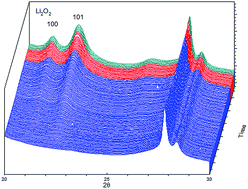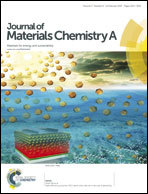Capillary based Li–air batteries for in situ synchrotron X-ray powder diffraction studies†
Abstract
For Li–air batteries to reach their full potential as energy storage system, a complete understanding of the conditions and reactions in the battery during operation is needed. To follow the reactions in situ a capillary-based Li–O2 battery has been developed for synchrotron-based in situ X-ray powder diffraction (XRPD). In this article, we present the results for the analysis of 1st and 2nd deep discharge and charge for a cathode being cycled between 2 and 4.6 V. The crystalline precipitation of Li2O2 only is observed in the capillary battery. However, there are indications of side reactions. The Li2O2 diffraction peaks grow with the same rate during charge and the development of the full width at half maximum (FWHM) is hkl dependent. The difference in the FWHM of the 100 and the 102 reflections indicate anisotropic morphology of the Li2O2 crystallites or defects along the c-axis. The effect of constant exposure of X-ray radiation to the electrolyte and cathode during charge of the battery was also investigated. X-ray exposure during charge leads to changes in the development of the intensity and the FWHM of the Li2O2 diffraction peaks. The X-ray diffraction results are supported by ex situ X-ray photoelectron spectroscopy (XPS) of discharged cathodes to illuminate non-crystalline deposited materials.


 Please wait while we load your content...
Please wait while we load your content...